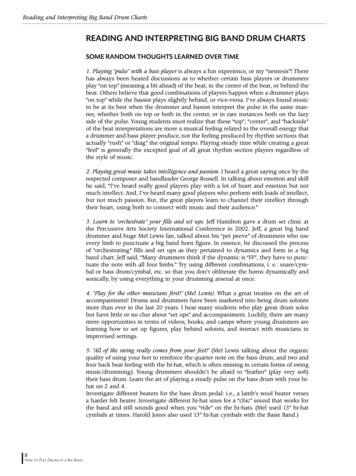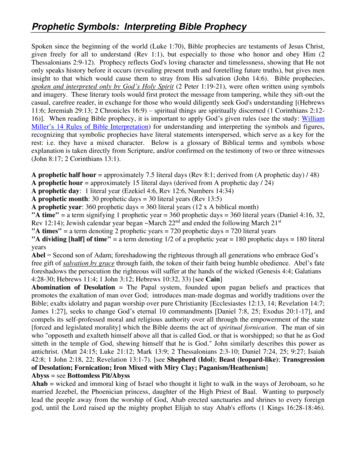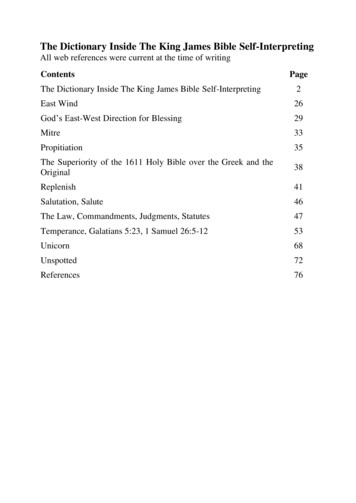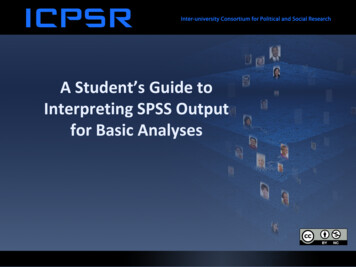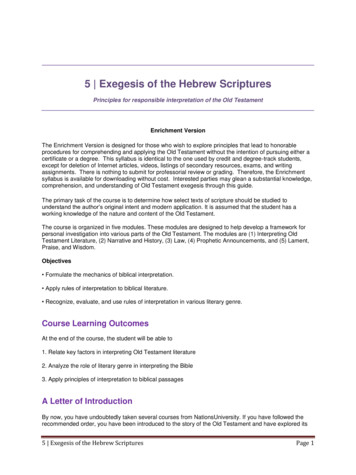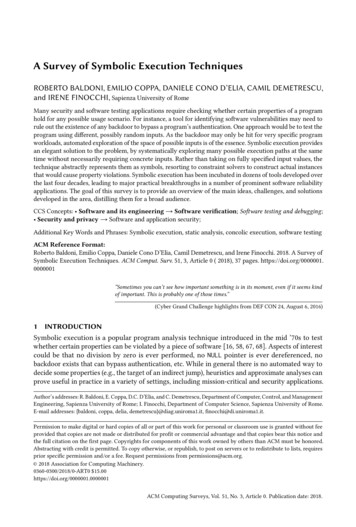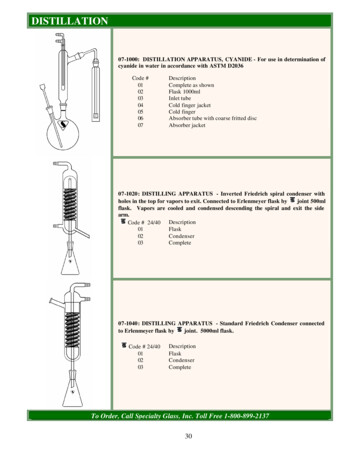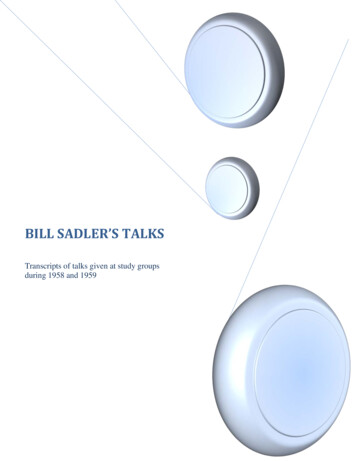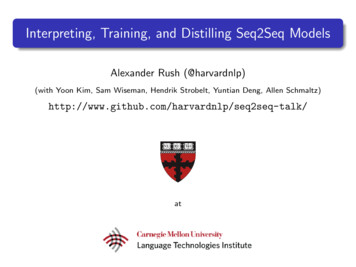
Transcription
Interpreting, Training, and Distilling Seq2Seq ModelsAlexander Rush (@harvardnlp)(with Yoon Kim, Sam Wiseman, Hendrik Strobelt, Yuntian Deng, Allen talk/at
Sequence-to-SequenceMachine Translation (Kalchbrenner and Blunsom, 2013; Sutskever et al.,2014b; Cho et al., 2014; Bahdanau et al., 2014; Luong et al., 2015)Question Answering (Hermann et al., 2015)Conversation (Vinyals and Le, 2015) (Serban et al., 2016)Parsing (Vinyals et al., 2014)Speech (Chorowski et al., 2015; Chan et al., 2015)Caption Generation (Karpathy and Li, 2015; Xu et al., 2015; Vinyals et al.,2015)Video-Generation (Srivastava et al., 2015)NER/POS-Tagging (Gillick et al., 2016)Summarization (Rush et al., 2015)
Sequence-to-SequenceMachine Translation (Kalchbrenner and Blunsom, 2013; Sutskever et al.,2014b; Cho et al., 2014; Bahdanau et al., 2014; Luong et al., 2015)Question Answering (Hermann et al., 2015)Conversation (Vinyals and Le, 2015) (Serban et al., 2016)Parsing (Vinyals et al., 2014)Speech (Chorowski et al., 2015; Chan et al., 2015)Caption Generation (Karpathy and Li, 2015; Xu et al., 2015; Vinyals et al.,2015)Video-Generation (Srivastava et al., 2015)NER/POS-Tagging (Gillick et al., 2016)Summarization (Rush et al., 2015)
Seq2Seq Neural Network ToolboxEmbeddingsRNNsSoftmaxsparse features dense featuresfeature sequences dense featuresdense features discrete predictions
Embeddingssparse features dense features
[Words Vectors]
RNNs/LSTMsfeature sequences dense features
LM/Softmaxdense features discrete predictionsp(wt w1 , . . . , wt 1 ; θ) softmax(Wout ht 1 bout )p(w1:T ) Ytp(wt w1 , . . . , wt 1 )
Contextual Language Model / “seq2seq”Key idea, contextual language model based on encoder x:Yp(w1:T x) p(wt w1 , . . . , wt 1 , x)t
Actual Seq2Seq / Encoder-Decoder / Attention-Based ModelsDifferent encoders, attention mechanisms, input feeding, .Almost all models use LSTMs or other gated RNNsLarge multi-layer networks necessary for good performance.4 layer, 1000 hidden dims is common for MT
Seq2Seq-AttnHarvardNLP’s open-source system (Yoon Kim)http://github.com/harvardnlp/seq2seq-attnUsed by SYSTRAN for 32 language pairs (Crego et al., 2016)
Seq2Seq Applications: Neural Summarization (Rush et al., 2015)Source (First Sentence)Russian Defense Minister Ivanov called Sunday for the creation of ajoint front for combating global terrorism.Target (Title)Russia calls for joint front against terrorism.(Mou et al., 2015) (Cheng and Lapata, 2016) (Toutanova et al., 2016) (Wanget al., 2016b) (Takase et al., 2016),among othersUsed by Washington Post to suggest headlines (Wang et al., 2016a)
Seq2Seq Applications: Neural Summarization (Rush et al., 2015)Source (First Sentence)Russian Defense Minister Ivanov called Sunday for the creation of ajoint front for combating global terrorism.Target (Title)Russia calls for joint front against terrorism.(Mou et al., 2015) (Cheng and Lapata, 2016) (Toutanova et al., 2016) (Wanget al., 2016b) (Takase et al., 2016),among othersUsed by Washington Post to suggest headlines (Wang et al., 2016a)
Seq2Seq Applications: Grammar Correction (Schmaltz et al., 2016)Source (Original Sentence)There is no a doubt, tracking systems has brought many benefits in thisinformation age .Target (Corrected Sentence)There is no doubt, tracking systems have brought many benefits in thisinformation age .1st on BEA’11 grammar correction task (Daudaravicius et al., 2016)
Seq2Seq Applications: Im2Markup (Deng and Rush, 2016)[Latex Example][Project]
This TalkHow can we interpret these learned hidden representations?How should we train these style of models?How can we shrink these models for practical applications?
This TalkHow can we interpret these learned hidden representations?LSTMVis lstm.seas.harvard.edu(Strobelt et al., 2016)How should we train these style of models? (Wiseman and Rush,2016)How can we shrink these models for practical applications? (Kimand Rush, 2016)
(?)
Vector-Space RNN Representation
(Karpathy et al., 2015)
Example 1: Synthetic (Finite-State) LanguageNumbers are randomly generated, must match nesting level.Train a predict-next-word language model (decoder-only).p(wt w1 , . . . , wt 1 )[Parens Example]
Example 2: Real Languagealphabet: all english wordscorpus: Project Gutenberg Children’s booksTrain a predict-next-word language model (decoder-only).p(wt w1 , . . . , wt 1 )[LM Example]
Example 3: Seq2Seq Encoderalphabet: all english wordscorpus: SummarizationTrain a full seq2seq model, examine encoder LSTM.[Summarization Example]
This TalkHow can we interpret these learned hidden representations?(Strobelt et al., 2016)How should we train these style of models?Sequence-to-Sequence Learning as Beam-Search Optimization(Wiseman and Rush, 2016)How can we shrink these models for practical applications (Kim andRush, 2016)?
Seq2Seq Notationx; source inputV; vocabularywt ; random variable for the t-th target token with support Vy1:T ; ground-truth outputŷ1:T ; predicted outputQp(w1:T x; θ) t p(wt w1:t 1 , x; θ); model distribution
Seq2Seq DetailsTrain Objective: Given source-target pairs (x, y1:T ), minimize NLL ofeach word independently, conditioned on gold history y1:t 1LNLL (θ) Xlog p(wt yt y1:t 1 , x; θ)tTest Objective: Structured predictionŷ1:T arg maxw1:TXlog p(wt w1:t 1 , x; θ)tTypical to approximate the arg max with beam-search
Beam Search (K 3)atheredFor t 1 . . . T :For all k and for all possible output words w:(k)(k)(k)s(w, ŷ1:t 1 ) log p(ŷ1:t 1 x) log p(w ŷ1:t 1 , x)Update beam:(1:K)ŷ1:t(k) K-arg max s(w, ŷ1:t 1 )
Beam Search (K 3)atheredFor t 1 . . . T :For all k and for all possible output words w:(k)(k)(k)s(w, ŷ1:t 1 ) log p(ŷ1:t 1 x) log p(w ŷ1:t 1 , x)Update beam:(1:K)ŷ1:t(k) K-arg max s(w, ŷ1:t 1 )
Beam Search (K 3)atheredFor t 1 . . . T :For all k and for all possible output words w:(k)(k)(k)s(w, ŷ1:t 1 ) log p(ŷ1:t 1 x) log p(w ŷ1:t 1 , x)Update beam:(1:K)ŷ1:t(k) K-arg max s(w, ŷ1:t 1 )
Beam Search (K 3)atheredFor t 1 . . . T :For all k and for all possible output words w:(k)(k)(k)s(w, ŷ1:t 1 ) log p(ŷ1:t 1 x) log p(w ŷ1:t 1 , x)Update beam:(1:K)ŷ1:t(k) K-arg max s(w, ŷ1:t 1 )
Beam Search (K 3)atheredFor t 1 . . . T :For all k and for all possible output words w:(k)(k)(k)s(w, ŷ1:t 1 ) log p(ŷ1:t 1 x) log p(w ŷ1:t 1 , x)Update beam:(1:K)ŷ1:t(k) K-arg max s(w, ŷ1:t 1 )
Beam Search (K 3)atheredFor t 1 . . . T :For all k and for all possible output words w:(k)(k)(k)s(w, ŷ1:t 1 ) log p(ŷ1:t 1 x) log p(w ŷ1:t 1 , x)Update beam:(1:K)ŷ1:t(k) K-arg max s(w, ŷ1:t 1 )
Beam Search (K 3)aredthedogredblueFor t 1 . . . T :For all k and for all possible output words w:(k)(k)(k)s(w, ŷ1:t 1 ) log p(ŷ1:t 1 x) log p(w ŷ1:t 1 , x)Update beam:(1:K)ŷ1:t(k) K-arg max s(w, ŷ1:t 1 )
Beam Search (K 3)areddogthedogdogredbluecatFor t 1 . . . T :For all k and for all possible output words w:(k)(k)(k)s(w, ŷ1:t 1 ) log p(ŷ1:t 1 x) log p(w ŷ1:t 1 , x)Update beam:(1:K)ŷ1:t(k) K-arg max s(w, ŷ1:t 1 )
Beam Search (K 3)areddogsmellsthedogdogbarksredbluecatwalksFor t 1 . . . T :For all k and for all possible output words w:(k)(k)(k)s(w, ŷ1:t 1 ) log p(ŷ1:t 1 x) log p(w ŷ1:t 1 , x)Update beam:(1:K)ŷ1:t(k) K-arg max s(w, ŷ1:t 1 )
Beam Search (K walksstraightFor t 1 . . . T :For all k and for all possible output words w:(k)(k)(k)s(w, ŷ1:t 1 ) log p(ŷ1:t 1 x) log p(w ŷ1:t 1 , x)Update beam:(1:K)ŷ1:t(k) K-arg max s(w, ŷ1:t 1 )
Beam Search (K yredbluecatwalksstraightnowFor t 1 . . . T :For all k and for all possible output words w:(k)(k)(k)s(w, ŷ1:t 1 ) log p(ŷ1:t 1 x) log p(w ŷ1:t 1 , x)Update beam:(1:K)ŷ1:t(k) K-arg max s(w, ŷ1:t 1 )
ProblemHow should we train sequence models?Related WorkApproaches to Exposure Bias, Label Bias:Data as Demonstrator, Scheduled Sampling (Venkatraman et al.,2015; Bengio et al., 2015)Globally Normalized Transition-Based Networks (Andor et al., 2016)RL-based approachesMIXER (Ranzato et al., 2016)Actor-Critic (Bahdanau et al., 2016)
ProblemHow should we train sequence models?Related WorkApproaches to Exposure Bias, Label Bias:Data as Demonstrator, Scheduled Sampling (Venkatraman et al.,2015; Bengio et al., 2015)Globally Normalized Transition-Based Networks (Andor et al., 2016)RL-based approachesMIXER (Ranzato et al., 2016)Actor-Critic (Bahdanau et al., 2016)
Issue #1: Train/Test Mismatch (cf., (Ranzato et al., 2016))NLL(θ) Xlog p(wt yt y1:t 1 , x; θ)t(a) Training conditions on true history (“Exposure Bias”)(b) Train with word-level NLL, but evaluate with BLEU-like metricsIdea #1: Train with beam-searchUse a loss that incorporates sequence-level costs
Issue #1: Train/Test Mismatch (cf., (Ranzato et al., 2016))NLL(θ) Xlog p(wt yt y1:t 1 , x; θ)t(a) Training conditions on true history (“Exposure Bias”)(b) Train with word-level NLL, but evaluate with BLEU-like metricsIdea #1: Train with beam-searchUse a loss that incorporates sequence-level costs
BSO Idea #1: Use a loss that incorporates sequence-level costsL(θ) Xhi(K)(K) (K) (ŷ1:t ) 1 s(yt , y1:t 1 ) s(ŷt , ŷ1:t 1 )t(K)y1:t is the gold prefix; ŷ1:t is the K’th prefix on the beam(K)(K) (ŷ1:t ) allows us to scale loss by badness of predicting ŷ1:t
BSO Idea #1: Use a loss that incorporates sequence-level costsL(θ) Xhi(K)(K) (K) (ŷ1:t ) 1 s(yt , y1:t 1 ) s(ŷt , ŷ1:t 1 )t(K)y1:t is the gold prefix; ŷ1:t is the K’th prefix on the beam(K)(K) (ŷ1:t ) allows us to scale loss by badness of predicting ŷ1:t
BSO Idea #1: Use a loss that incorporates sequence-level costsL(θ) Xhi(K)(K) (K) (ŷ1:t ) 1 s(yt , y1:t 1 ) s(ŷt , ŷ1:t 1 )t(K)y1:t is the gold prefix; ŷ1:t is the K’th prefix on the beam(K)(K) (ŷ1:t ) allows us to scale loss by badness of predicting ŷ1:t
BSO Idea #1: Use a loss that incorporates sequence-level costsL(θ) Xhi(K)(K) (K) (ŷ1:t ) 1 s(yt , y1:t 1 ) s(ŷt , ŷ1:t 1 )t(K)y1:t is the gold prefix; ŷ1:t is the K’th prefix on the beam(K)(K) (ŷ1:t ) allows us to scale loss by badness of predicting ŷ1:t
Issue #2: Seq2Seq models next-word probabilities:(k)(k)(k)s(w, ŷ1:t 1 ) log p(ŷ1:t 1 x) log p(w ŷ1:t 1 , x)(a) Sequence score is sum of locally normalized word-scores; gives riseto “Label Bias” (Lafferty et al., 2001)(b) What if we want to train with sequence-level constraints?Idea #2: Don’t locally normalize
Issue #2: Seq2Seq models next-word probabilities:(k)(k)(k)s(w, ŷ1:t 1 ) log p(ŷ1:t 1 x) log p(w ŷ1:t 1 , x)(a) Sequence score is sum of locally normalized word-scores; gives riseto “Label Bias” (Lafferty et al., 2001)(b) What if we want to train with sequence-level constraints?Idea #2: Don’t locally normalize
BSO Idea #2: Don’t locally normalize(k)h2(k)y2h1y1(k)(k)(k)h3(k)(k)y3(k)(k) RNN(y3 , h2 )(k)(k)s(w, ŷ1:t 1 ) log p(ŷ1:t 1 x) log softmax(Wout ht 1 bout )
BSO Idea #2: Don’t locally normalize(k)h2(k)y2h1y1(k)(k)h3(k)y3(k)(k)(k)(k) RNN(y3 , h2 )(k)(k)s(w, ŷ1:t 1 ) log p(ŷ1:t 1 x) log softmax(Wout ht 1 bout )(k) Wout ht 1 bout
BSO Idea #2: Don’t locally normalize(k)h2(k)y2h1y1(k)(k)h3(k)(k)y3(k)(k) RNN(y3 , h2 )(k)(k)(k)s(w, ŷ1:t 1 ) log p(ŷ1:t 1 x) log softmax(Wout ht 1 bout )(k) Wout ht 1 bout(k)(k)Can set s(w, ŷ1:t 1 ) if (w, ŷ1:t 1 ) violates a hard constraint
Beam Search OptimizationatheredL(θ) Xhi(K)(K) (K) (ŷ1:t ) 1 s(yt , y1:t 1 ) s(ŷt , ŷ1:t 1 )tColor Gold: target sequence yColor Gray: violating sequence ŷ (K)
Beam Search OptimizationL(θ) Xaredthedogredbluehi(K)(K) (K) (ŷ1:t ) 1 s(yt , y1:t 1 ) s(ŷt , ŷ1:t 1 )tColor Gold: target sequence yColor Gray: violating sequence ŷ (K)
Beam Search OptimizationL(θ) areddogthedogdogredbluecatXhi(K)(K) (K) (ŷ1:t ) 1 s(yt , y1:t 1 ) s(ŷt , ŷ1:t 1 )tColor Gold: target sequence yColor Gray: violating sequence ŷ (K)
Beam Search arksrunsL(θ) Xhi(K)(K) (K) (ŷ1:t ) 1 s(yt , y1:t 1 ) s(ŷt , ŷ1:t 1 )tColor Gold: target sequence yColor Gray: violating sequence ŷ (K)
Beam Search arksrunsL(θ) X(K) (ŷ1:t ) (K) (K)1 s(yt , y1:t 1 ) s(ŷt , ŷ1:t 1 )tLaSO (Daumé III and Marcu, 2005):If no margin violation at t 1, update beam as usualOtherwise, update beam with sequences prefixed by y1:t 1
Beam Search arksrunsL(θ) X(K) (ŷ1:t ) (K) (K)1 s(yt , y1:t 1 ) s(ŷt , ŷ1:t 1 )tLaSO (Daumé III and Marcu, 2005):If no margin violation at t 1, update beam as usualOtherwise, update beam with sequences prefixed by y1:t 1
Beam Search arksrunsL(θ) X(K) (ŷ1:t ) (K) (K)1 s(yt , y1:t 1 ) s(ŷt , ŷ1:t 1 )tLaSO (Daumé III and Marcu, 2005):If no margin violation at t 1, update beam as usualOtherwise, update beam with sequences prefixed by y1:t 1
Beam Search redbluecatbarksstraightrunsL(θ) X(K) (ŷ1:t ) (K) (K)1 s(yt , y1:t 1 ) s(ŷt , ŷ1:t 1 )tLaSO (Daumé III and Marcu, 2005):If no margin violation at t 1, update beam as usualOtherwise, update beam with sequences prefixed by y1:t 1
Beam Search catbarksquicklyFridaybarksstraightnowrunsL(θ) X(K) (ŷ1:t )today (K) (K)1 s(yt , y1:t 1 ) s(ŷt , ŷ1:t 1 )tLaSO (Daumé III and Marcu, 2005):If no margin violation at t 1, update beam as usualOtherwise, update beam with sequences prefixed by y1:t 1
Backpropagation over runsquicklytodaybluedogbarkshomenow
ExperimentsWord Ordering, Dependency Parsing, Machine TranslationUses LSTM encoders and decoders, attention, input feedingAll models trained with Adagrad (Duchi et al., 2011)Pre-trained with NLL; K increased gradually“BSO” uses unconstrained search; “ConBSO” uses constraints
Ke 1Ke 5Ke 10Word Ordering 34.334.5Dependency Parsing , SB- , Kt .40MIXER20.7321.8121.83Machine Translation (BLEU)1Note Andor et al. (2016) have SOA, with 94.41/92.55.
This TalkHow can we interpret these learned hidden representations?(Strobelt et al., 2016)How should we train these style of models? (Wiseman and Rush,2016)How can we shrink these models for practical applications?Sequence-Level Knowledge Distillation(Kim and Rush, 2016)
Neural Machine TranslationExcellent results on many language pairs, but need large modelsOriginal seq2seq paper (Sutskever et al., 2014a): 4-layers/1000 unitsDeep Residual RNNs (Zhou et al., 2016) : 16-layers/512 unitsGoogle’s NMT system (Wu et al., 2016): 8-layers/1024 unitsBeam search ensemble on top Deployment is challenging!
Neural Machine TranslationExcellent results on many language pairs, but need large modelsOriginal seq2seq paper (Sutskever et al., 2014a): 4-layers/1000 unitsDeep Residual RNNs (Zhou et al., 2016) : 16-layers/512 unitsGoogle’s NMT system (Wu et al., 2016): 8-layers/1024 unitsBeam search ensemble on top Deployment is challenging!
Related Work: Compressing Deep ModelsPruning: Prune weights based on importance criterion (LeCun et al.,1990; Han et al., 2016; See et al., 2016)Knowledge Distillation: Train a student model to learn from ateacher model (Bucila et al., 2006; Ba and Caruana, 2014; Hinton et al.,2015; Kuncoro et al., 2016).(Sometimes called “dark knowledge”)
Knowledge Distillation (Bucila et al., 2006; Hinton et al., 2015)Train a larger teacher model first to obtain teacher distribution q(·)Train a smaller student model p(·) to mimic the teacherWord-Level Knowledge DistillationTeacher distribution: q(wt y1:t 1 )LNLL XXtLWORD-KD XXt1{yt k} log p(wt k y1:t 1 ; θ)k Vk Vq(wt k y1:t 1 ) log p(wt k y1:t 1 ; θ)
Knowledge Distillation (Bucila et al., 2006; Hinton et al., 2015)Train a larger teacher model first to obtain teacher distribution q(·)Train a smaller student model p(·) to mimic the teacherWord-Level Knowledge DistillationTeacher distribution: q(wt y1:t 1 )LNLL XXtLWORD-KD XXt1{yt k} log p(wt k y1:t 1 ; θ)k Vk Vq(wt k y1:t 1 ) log p(wt k y1:t 1 ; θ)
No Knowledge Distillation
Word-Level Knowledge Distillation
Word-Level Knowledge Distillation
Word-Level Knowledge Distillation ResultsEnglish German (WMT 2014)ModelBLEU4 1000 Teacher19.52 500 Baseline (No-KD)17.62 500 Student (Word-KD)17.72 300 Baseline (No-KD)16.92 300 Student (Word-KD)17.6
This Work: Sequence-Level Knowledge DistillationLNLL XXtLWORD-KD XXt1{yt k} log p(wt k y1:t 1 )k Vq(wt k y1:t 1 ) log p(wt k y1:t 1 )k VInstead minimize cross-entropy, between q and p impliedsequence-distributionsLSEQ-KD Xw1:Tq(w1:T x) log p(w1:T x) V TSum over an exponentially-sized set V T .
This Work: Sequence-Level Knowledge DistillationLNLL XXtLWORD-KD XXt1{yt k} log p(wt k y1:t 1 )k Vq(wt k y1:t 1 ) log p(wt k y1:t 1 )k VInstead minimize cross-entropy, between q and p impliedsequence-distributionsLSEQ-KD Xw1:Tq(w1:T x) log p(w1:T x) V TSum over an exponentially-sized set V T .
Sequence-Level Knowledge DistillationApproximate q(w x) with modeq(w1:T x) 1{arg max q(w1:T x)}w1:TApproximate mode with beam searchŷ arg max q(w1:T x)w1:TSimple model: train the student model on ŷ with NLL
Sequence-Level Knowledge DistillationApproximate q(w x) with modeq(w1:T x) 1{arg max q(w1:T x)}w1:TApproximate mode with beam searchŷ arg max q(w1:T x)w1:TSimple model: train the student model on ŷ with NLL
Sequence-Level Knowledge DistillationApproximate q(w x) with modeq(w1:T x) 1{arg max q(w1:T x)}w1:TApproximate mode with beam searchŷ arg max q(w1:T x)w1:TSimple model: train the student model on ŷ with NLL
Sequence-Level Knowledge Distillation
Sequence-Level Knowledge Distillation
Sequence-Level InterpolationWord-level knowledge distillationL αLWORD-KD (1 α)LNLLTraining the student towards the mixture of teacher/data distributions.How can we incorporate ground truth data at the sequence-level?
Sequence-Level Interpolation
Sequence-Level Interpolation
Experiments on English German (WMT 2014)Word-KD: Word-level Knowledge DistillationSeq-KD: Sequence-level Knowledge Distillation with beam sizeK 5Seq-Inter: Sequence-level Interpolation with beam size K 35.Fine-tune from pretrained Seq-KD (or baseline) model with smallerlearning rate.
Results: English German (WMT 2014)ModelBLEUK 1 K 1BLEUK 5 K 5PPLp(ŷ)17.7 19.5 6.71.3%14.7 17.6 8.20.9%4 1000Teacher2 500Student
Results: English German (WMT 2014)ModelBLEUK 1 K 1BLEUK 5 K 5PPLp(ŷ)17.7 19.5 6.71.3%14.7 17.6 8.20.9%15.4 0.717.7 0.18.01.0%4 1000Teacher2 500StudentWord-KD
Results: English German (WMT 2014)ModelBLEUK 1 K 1BLEUK 5 K 5PPLp(ŷ)17.7 19.5 6.71.3%14.7 17.6 8.20.9%4 1000Teacher2 500StudentWord-KD15.4 0.717.7 0.18.01.0%Seq-KD18.9 4.219.0 1.422.716.9%
Results: English German (WMT 2014)ModelBLEUK 1 K 1BLEUK 5 K 5PPLp(ŷ)17.7 19.5 6.71.3%14.7 17.6 8.20.9%4 1000Teacher2 500StudentWord-KD15.4 0.717.7 0.18.01.0%Seq-KD18.9 4.219.0 1.422.716.9%Seq-Inter18.9 4.219.3 1.715.87.6%
Results: English German (WMT 2014)ModelBLEUK 1 K 1BLEUK 5 K 5PPLp(ŷ)17.7 19.5 6.71.3%19.6 1.919.8 0.310.48.2%14.7 17.6 8.20.9%4 1000TeacherSeq-Inter2 500StudentWord-KD15.4 0.717.7 0.18.01.0%Seq-KD18.9 4.219.0 1.422.716.9%Seq-Inter18.9 4.219.3 1.715.87.6%
Results: English German (WMT 2014)ModelBLEUK 1 K 1BLEUK 5 K 5PPLp(ŷ)17.7 19.5 6.71.3%19.6 1.919.8 0.310.48.2%14.7 17.6 8.20.9%Word-KD15.4 0.717.7 0.18.01.0%Seq-KD18.9 4.219.0 1.422.716.9%Seq-Inter18.9 4.219.3 1.715.87.6%4 1000TeacherSeq-Inter2 500StudentMany more experiments (different language pairs, combining configurations,different sizes etc.) in paper
An Application[App]
Decoding Speed
Combining Knowledge Distillation and PruningNumber of parameters still large for student models (mostly due toword embedding tables)4 1000: 221 million2 500: 84 million2 300: 49 millionPrune student model: Same methodology as See et al. (2016)Prune x% of weights based on absolute valueFine-tune pruned model (crucial!)
Combining Knowledge Distillation and PruningNumber of parameters still large for student models (mostly due toword embedding tables)4 1000: 221 million2 500: 84 million2 300: 49 millionPrune student model: Same methodology as See et al. (2016)Prune x% of weights based on absolute valueFine-tune pruned model (crucial!)
Combining Knowledge Distillation and Pruning
Conclusion: Other workHow can we interpret these learned hidden representations?Lei et al. (2016) other methods for interpreting decisions (asopposed to states).How should we train these style of models?Lee et al. (2016) CCG parsing (backprop through search is a thingnow/again)How can we shrink these models for practical applications?Live deployment: (greedy) student outperforms (beam search)teacher. (Crego et al., 2016)Can compress an ensemble into a single model (Kuncoro et al., 2016)
Coming WorkStructured Attention Networks (Kim et al 3x4(b)(c)
Thanks!
References IAndor, D., Alberti, C., Weiss, D., Severyn, A., Presta, A., Ganchev, K.,Petrov, S., and Collins, M. (2016). Globally Normalized Transition-BasedNeural Networks. arXiv, cs.CL.Ba, L. J. and Caruana, R. (2014). Do Deep Nets Really Need to be Deep? InProceedings of NIPS.Bahdanau, D., Brakel, P., Xu, K., Goyal, A., Lowe, R., Pineau, J., Courville,A., and Bengio, Y. (2016). An Actor-Critic Algorithm for SequencePrediction.Bahdanau, D., Cho, K., and Bengio, Y. (2014). Neural machine translation byjointly learning to align and translate. CoRR, abs/1409.0473.Bengio, S., Vinyals, O., Jaitly, N., and Shazeer, N. (2015). Scheduled samplingfor sequence prediction with recurrent neural networks. In Advances inNeural Information Processing Systems, pages 1171–1179.
References IIBucila, C., Caruana, R., and Niculescu-Mizil, A. (2006). Model Compression.In Proceedings of KDD.Chan, W., Jaitly, N., Le, Q., and Vinyals, O. (2015). Listen, Attend and Spell.arXiv:1508.01211.Cheng, J. and Lapata, M. (2016). Neural summarization by extractingsentences and words. arXiv preprint arXiv:1603.07252.Cho, K., van Merrienboer, B., Gulcehre, C., Bahdanau, D., Bougares, F.,Schwenk, H., and Bengio, Y. (2014). Learning Phrase Representations usingRNN Encoder-Decoder for Statistical Machine Translation. In Proceedingsof EMNLP.Chorowski, J., Bahdanau, D., and Serdyuk, D. (2015). Attention-based modelsfor speech recognition. Advances in Neural.Crego, J., Kim, J., and Senellart, J. (2016). Systran’s pure neural machinetranslation system. arXiv preprint arXiv:1602.06023.
References IIIDaudaravicius, V., Banchs, R. E., Volodina, E., and Napoles, C. (2016). AReport on the Automatic Evaluation of Scientific Writing Shared Task.NAACL BEA11 Workshop, pages 53–62.Daumé III, H. and Marcu, D. (2005). Learning as search optimization:approximate large margin methods for structured prediction. In Proceedingsof the Twenty-Second International Conference on Machine Learning{(ICML} 2005), pages 169–176.Duchi, J., Hazan, E., and Singer, Y. (2011). Adaptive Subgradient Methodsfor Online Learning and Stochastic Optimization. The Journal of MachineLearning Research, 12:2121–2159.Gillick, D., Brunk, C., Vinyals, O., and Subramanya, A. (2016). MultilingualLanguage Processing from Bytes. In Proceedings of NAACL.
References IVHan, S., Mao, H., and Dally, W. J. (2016). Deep Compression: CompressingDeep Neural Networks with Pruning, Trained Quantization and HuffmanCoding. In Proceedings of ICLR.Hermann, K., Kocisky, T., and Grefenstette, E. (2015). Teaching machines toread and comprehend. Advances in Neural.Hinton, G., Vinyals, O., and Dean, J. (2015). Distilling the Knowledge in aNeural Network. arXiv:1503.0253.Kalchbrenner, N. and Blunsom, P. (2013). Recurrent continuous translationmodels. In EMNLP, pages 1700–1709.Karpathy, A., Johnson, J., and Li, F.-F. (2015). Visualizing and understandingrecurrent networks. ICLR Workshops.Karpathy, A. and Li, F.-F. (2015). Deep visual-semantic alignments forgenerating image descriptions. In Proceedings of the IEEE Conference onComputer Vision and Pattern Recognition, pages 3128–3137.
References VKim, Y. and Rush, A. M. (2016). Sequence-Level Knowledge Distillation.Kuncoro, A., Ballesteros, M., Kong, L., Dyer, C., and Smith, N. A. (2016).Distilling an Ensemble of Greedy Dependency Parsers into One MST Parser.In Proceedings of EMNLP.Lafferty, J. D., McCallum, A., and Pereira, F. C. N. (2001). Conditionalrandom fields: Probabilistic models for segmenting and labeling sequencedata. In Proceedings of the Eighteenth International Conference on MachineLearning (ICML 2001), pages 282–289.LeCun, Y., Denker, J. S., and Solla, S. A. (1990). Optimal Brain Damage. InProceedings of NIPS.Luong, M.-T., Pham, H., and Manning, C. D. (2015). Effective Approaches toAttention-based Neural Machine Translation. In EMNLP, numberSeptember, page 11.
References VIMou, L., Yan, R., Li, G., Zhang, L., and Jin, Z. (2015). Backward and forwardlanguage modeling for constrained sentence generation. arXiv preprintarXiv:1512.06612.Ranzato, M., Chopra, S., Auli, M., and Zaremba, W. (2016). Sequence LevelTraining with Recurrent Neural Networks. ICLR, pages 1–15.Rush, A. M., Chopra, S., and Weston, J. (2015). A Neural Attention Modelfor Abstractive Sentence Summarization. In Proceedings of the Conferenceon Empirical Methods in Natural Language Processing (EMNLP),(September):379–389.Schmaltz, A., Kim, Y., Rush, A. M., and Shieber, S. M. (2016).Sentence-Level Grammatical Error Identification as Sequence-to-SequenceCorrection.See, A., Luong, M.-T., and Manning, C. D. (2016). Compression of NeuralMachine Translation via Pruning. In Proceedings of CoNLL.
References VIISerban, I. V., Sordoni, A., Bengio, Y., Courville, A., and Pineau, J. (2016).Building End-to-End Dialogue Systems Using Generative Hierarchical NeuralNetwork Models. In Proceedings of AAAI.Srivastava, N., Mansimov, E., and Salakhutdinov, R. (2015). UnsupervisedLearning of Video Representations using LSTMs. Proceedings of ICML.Strobelt, H., Gehrmann, S., Huber, B., Pfister, H., and Rush, A. M. (2016).Visual Analysis of Hidden State Dynamics in Recurrent Neural Networks.Sutskever, I., Vinyals, O., and Le, Q. (2014a). Sequence to Sequence Learningwith Neural Networks.Sutskever, I., Vinyals, O., and Le, Q. V. (2014b). Sequence to sequencelearning with neural networks. In Advances in Neural Information ProcessingSystems, pages 3104–3112.Takase, S., Suzuki, J., Okazaki, N., Hirao, T., and Nagata, M. (2016). Neuralheadline generation on abstract meaning representation.
References VIIIToutanova, K., Tran, K. M., and Amershi, S. (2016). A dataset and evaluationmetrics for abstractive compression of sentences and short paragraphs.Venkatraman, A., Boots, B., Hebert, M., and Bagnell, J. (2015). DATA ASDEMONSTRATOR with Applications to System Identification.pdfs.semanticscholar.org.Vinyals, O., Kaiser, L., Koo, T., Petrov, S., Sutskever, I., and Hinton, G.(2014). Grammar as a Foreign Language. In arXiv, pages 1–10.Vinyals, O. and Le, Q. (2015). A neural conversational model. arXiv preprintarXiv:1506.05869.Vinyals, O., Toshev, A., Bengio, S., and Erhan, D. (2015). Show and Tell: ANeural Image Caption Generator. In Proceedings of CVPR.Wang, S., Han, S., and Rush, A. M. (2016a). Headliner.Computation Journalism.
References IXWang, T., Chen, P., Amaral, K., and Qiang, J. (2016b). An experimentalstudy of lstm encoder-decoder model for text simplification. arXiv preprintarXiv:1609.03663.Wiseman, S. and Rush, A. M. (2016). Sequence-to-Sequence Learning asBeam-Search Optimization.Wu, Y., Schuster, M., Chen, Z., Le, Q. V., Norouzi, M., Macherey, W.,Krikun, M., Cao, Y., Gao, Q., Macherey, K., Klingner, J., Shah, A.,Johnson, M., Liu, X., Kaiser, L., Gouws, S., Kato, Y., Kudo, T., Kazawa,H., Stevens, K., Kurian, G., Patil, N., Wang, W., Young, C., Smith, J.,Riesa, J., Rudnick, A., Vinyals, O., Corrado, G., Hughes, M., and Dean, J.(2016). Google’s Neural Machine Translation System: Bridging the Gapbetween Human and Machine Translation. arXiv:1606.09.08144.
References XXu, K., Ba, J., Kiros, R., Cho, K., Courville, A., Salakhutdinov, R., Zemel, R.,and Bengio, Y. (2015). Show, Attend and Tell: Neural Image CaptionGeneration with Visual Attention. ICML.Zhou, J., Cao, Y., Wang, X., Li, P., and Xu, W. (2016). Deep RecurrentModels with Fast-Forward Connections for Neural Machine Translation. InProceedings of TACL.
(Mou et al., 2015) (Cheng and Lapata, 2016) (Toutanova et al., 2016) (Wang et al., 2016b) (Taka
